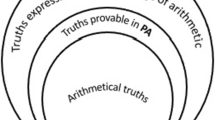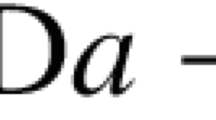Abstract
It is often remarked that first-order Peano Arithmetic is non-categorical but deductively well-behaved, while second-order Peano Arithmetic is categorical but deductively ill-behaved. This suggests that, when it comes to axiomatizations of mathematical theories, expressive power and deductive power may be orthogonal, mutually exclusive desiderata. In this paper, I turn to Hintikka’s (Philos Top 17(2):69–90, 1989) distinction between descriptive and deductive approaches in the foundations of mathematics to discuss the implications of this observation for the first-order logic versus second-order logic divide. The descriptive approach is illustrated by Dedekind’s ‘discovery’ of the need for second-order concepts to ensure categoricity in his axiomatization of arithmetic; the deductive approach is illustrated by Frege’s Begriffsschrift project. I argue that, rather than suggesting that any use of logic in the foundations of mathematics is doomed to failure given the impossibility of combining the descriptive approach with the deductive approach, what this apparent predicament in fact indicates is that the first-order versus second-order divide may be too crude to investigate what an adequate axiomatization of arithmetic should look like. I also conclude that, insofar as there are different, equally legitimate projects one may engage in when working on the foundations of mathematics, there is no such thing as the One True Logic for this purpose; different logical systems may be adequate for different projects.
Similar content being viewed by others
Notes
Naturally, PA1 is not that much of a success in terms of deductive power either. For starters, the underlying logic, first-order logic, is only semi-decidable, and of course, any (first-order or otherwise) system containing arithmetic (in a suitable sense of containing) is itself deductively incomplete. However, in comparison with the deductively hopeless PA2, PA1 may still seem more promising.
Naturally, how the mathematician has epistemicaccess to the properties of these abstract structures is a notoriously thorny epistemic problem for the Platonist—the well-known ‘Benacerraf challenge’ (Benacerraf 1973).
However, the paragraph then continues (emphasis added): “And how should we divest these properties of their specifically arithmetic character so that they are subsumed under more general notions and under activities of the understanding without which no thinking is possible at all but with which a foundation is provided for the reliability and completeness of proofs and for the construction of consistent notions and definitions?” So there is a sense in which Dedekind is also interested in the deductive perspective. (I owe this point to an anonymous referee.) Nevertheless, the focus of his work on the natural numbers remains descriptive and ‘model-centric’, as also argued by Blanchette. (It is also interesting to notice the clear Kantian undertones of this passage).
See (Shapiro 1991, Chapter 7) for the history of the ‘triumph’ of first-order languages.
Why the so-called intended models of arithmetic should have a privileged status vis-à-vis the so-called non-standard models is in itself an interesting philosophical question. Many researchers working on the topic in fact see the non-standard models as fascinating structures in their own right, not as ‘alien intruders’ (Enayat and Kossak 2004). However, from the point of view of Dedekind’s project, he clearly started with a very specific structure in mind, and sought to characterize it completely and uniquely. From this point of view, non-categoricity is indeed a failure.
As argued by Blanchette (2014). Her idea is that Hilbert’s interest in models at that stage was essentially motivated by the idea of non-deducibility rather than by interest in those models as such. “Because models are a tool for showing non-deducibility, there is no interest in a ‘range of models’ or in claims about truth across ‘all models’.”
( Cohen 2010, chap. 4) surveys some other systems between first-order logic and second-order logic that can also be (and have been) used for axiomatizations of arithmetic.
When it comes to providing foundations for the whole of mathematics, not only arithmetic, currently the ‘dispute’ is not so much between first-order and second-order logic (a rather different panorama with respect to when (Shapiro 1991) appeared), but between second-order logic and set theory (Väänänen 2001, 2012). However, insofar as set-theory is usually conceived of as a first-order theory, the dichotomy is still present.
Read (1997, section 11) discusses a number of other ‘logical solutions’ to the issue of formulating intermediate systems (i.e. extensions of first-order logic) so as to ensure categoricity, such as so-called ‘weak second-order logic’ (which allows second-order quantification only over finite sets).
To be sure, other legitimate, interesting projects in the foundations of mathematics may well arise in the future. Indeed, there is no reason to be sure that at this point we have exhausted the interesting connections between logic and mathematics for the foundations of mathematics.
References
Ahrens, B., Kapulkin, C. & Shulman, M. (2013). Univalent categories and the Rezk completion. Retrieved from http://arxiv.org/abs/1303.0584.
Awodey, Steve (2010). Type theory and homotopy. Retrieved from http://arxiv.org/abs/1010.1810.
Awodey, S., & Reck, E. H. (2002a). Completeness and categoricity. Part I: Nineteenth-century axiomatics to twentieth-century metalogic. History and Philosophy of Logic, 23(1), 1–30.
Awodey, S., & Reck, E. H. (2002b). Completeness and categoricity. Part II: twentieth-century metalogic to twenty-first-century semantics. History and Philosophy of Logic, 23(2), 77–94.
Avron, A. (2003). Transitive closure and the mechanization of mathematics. In F. Kamareddine (Ed.), Thirty five years of automating mathematics (pp. 149–171). Dordrecht: Kluwer.
Benacerraf, P. (1973). Mathematical truth. Journal of Philosophy, 70(19), 661–679.
Blanchette, P. (2014). The birth of semantic entailment. Slides, talk at the Logic Colloquium, Vienna, 16 July 2014.
Bueno, O. (2010). A defense of second-order logic. Axiomathes, 20(2–3), 365–383.
Cohen, L. (2010). Ancestral Logic and Equivalent Systems. M.S. thesis, Tel Aviv University.
Corcoran, J. (1973). Gaps between logical theory and mathematical practice. In M. Bunge (Ed.), The methodological unity of science. Dordrecht: Kluwer.
Enayat, A., & Roman, K. (Eds.). (2004). Nonstandard models of arithmetic and set theory, contemporary mathematics (Vol. 361). Providence, Rhode Island: American Mathematical Society.
Frege, Gottlob (1879/1977). Begriffsschrift. In Jean van Heijenoort (ed.), From Frege to Gödel: a source book in mathematical logic 1879–1931 (pp. 1–82). Harvard Unversity Press, Cambridge, 1967.
Hintikka, J. (1989). Is there completeness in mathematics after Gödel? Philosophical Topics, 17(2), 69–90.
Levesque, H., & Ronald, J. B. (1987). Expressiveness and tractability in knowledge representation and reasoning. Computational Intelligence, 3, 78–93.
Quine, W. V. (1970). Philosophy of Logic. Englewood Cliffs: Prentice-Hall.
Read, S. (1997). Completeness and categoricity: Frege, Gödel and model theory. History and Philosophy of Logic, 18(2), 79–93.
Reck, E. (2011). Dedekind’s contributions to the foundations of mathematics. In E. Zalta (Ed.), Stanford encyclopedia of philosophy. Available at http://plato.stanford.edu/entries/dedekind-foundations/.
Rossberg, Marcus. (2004). First-order logic, second-order logic, and completeness. In Vincent Hendricks, Fabian Neuhaus, Stig Andur Pedersen, Uwe Scheffler, & Heinrich Wansing (Eds.), First-order logic revisited (pp. 303–321). Berlin: Logos.
Russell, G. (2013). Logical Pluralism. Stanford Encyclopedia of Philosophy.
Shapiro, S. (1985). Second-order languages and mathematical practice. Journal of Symbolic Logic, 50(3), 714–742.
Shapiro, S. (1991). Foundations without foundationalism: A case for second-order logic. New York: Oxford University Press.
Sieg, W. (1994). Mechanical procedures and mathematical experience. In A. George (Ed.), Mathematics and mind (pp. 71–117). New York: Oxford University Press.
Smith, P. (2008). Ancestral arithmetic and Isaacson’s thesis. Analysis, 68(297), 1–10.
Tennant, N. (2000). Deductive versus expressive power: A pre-gödelian predicament. Journal of Philosophy, 97(5), 257–277.
Väänänen, J. (2001). Second-order logic and foundations of mathematics. Bulletin of Symbolic Logic, 7(4), 504–520.
Väänänen, J. (2012). Second order logic or set theory? Bulletin of Symbolic Logic, 18(1), 91–121.
Acknowledgments
Thanks to Jeffrey Ketland for helpful comments on the paper. I first stated thinking about these issues when supervising the Master’s thesis of Nicola di Giorgio in 2010, so thanks to Nicola for prompting me to think about this material.
Author information
Authors and Affiliations
Corresponding author
Rights and permissions
About this article
Cite this article
Dutilh Novaes, C. Axiomatizations of arithmetic and the first-order/second-order divide. Synthese 196, 2583–2597 (2019). https://doi.org/10.1007/s11229-014-0636-6
Received:
Accepted:
Published:
Issue Date:
DOI: https://doi.org/10.1007/s11229-014-0636-6




